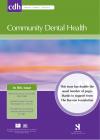Community Dental Health

- Cover Date:
- March 2011
- Print ISSN:
- 0265 539X
- Vol:
- 28
- Issue:
- 1
Comparison of the COHIP and OHIP- 14 as measures of the oral health-related quality of life of adolescents
Aim: To compare the validity and reliability of the Oral Health Impact Profile-14 (OHIP-14) and the Child Oral Health Impact Profile (COHIP) for investigating oral health related quality of life (OHRQoL) of adolescents. Method: We studied 234 adolescents from two publicly funded schools in Hamedan, Iran. Participants completed questionnaires and had a clinical examination. We compared convergent and discriminative validity of the instruments by analyzing their association with self reported health indicators and number of decayed teeth. Results: Both instruments showed good convergence with self-rated health and self-rated oral health. Those who perceived dental treatment needs, who had experienced dental pain in last month, were more dissatisfied with their oral health, or had more decayed teeth scored higher on both OHIP-14 and COHIP. The discriminative validity of the two instruments varied slightly and inconsistently. The convergent and discriminative validity of both instruments were established independent of their scoring methods. Conclusion: Both the OHIP-14 and COHIP were valid and reliable measures for investigating OHRQoL among 15-17 year old adolescents. The COHIP is preferable when the aim is identifying more impacts. Both measures have shown good convergent and discriminative validity, however, for practical reasons; the shorter instrument (OHIP-14) may be more suitable for epidemiological studies.
Key words: Adolescent, epidemiology, oral health related quality of life, oral health.
- Article Price
- £15.00
- Institution Article Price
- £
- Page Start
- 82
- Page End
- 88
- Authors
- V. Ravaghi, M.M. Mokhatry Ardakan, S. Shahriari, N. Mokhtari, M. Underwood
Articles from this issue
- Title
- Pg. Start
- Pg. End
- The caries experience of 5 year-old children in Scotland, Wales and England in 2007-2008 and the impact of consent arrangements. Reports of co-ordinated surveys using BASCD criteria
- 5
- 11
- The dilemma of selecting suitable proximal carious lesions in primary molars for restoration using ART technique.
- 12
- 16
- Using laser fluorescence (DIAGNOdent) in surveys for the detection of noncavitated occlusal dentine caries
- 17
- 21
- The prevalence of and risk factors for non-carious cervical lesions in adults in Hubei Province, China
- 22
- 28
- Health-related lifestyle behaviours, socio-demographic characteristics and use of dental health services in Greek adults.
- 47
- 52
- Periodontal health and treatment needs among hospitalized chronic psychiatric patients in Istanbul, Turkey
- 69
- 74
- Comparison of the COHIP and OHIP- 14 as measures of the oral health-related quality of life of adolescents
- 82
- 88
- Assessment and comparison of periodontal status among young smokers and nonsmokers of Bangalore, India - a cross sectional study.
- 89
- 94
- Smoking and drinking habits and attitudes to smoking cessation counselling among Tanzanian dental students
- 95
- 98
- Traumatic dental injuries to primary incisors and the terminal or occlusal plane relationship in Indian preschool children
- 104
- 106
- Teaching dental public health to undergraduates using community profiles and patient case studies
- 116
- 120
